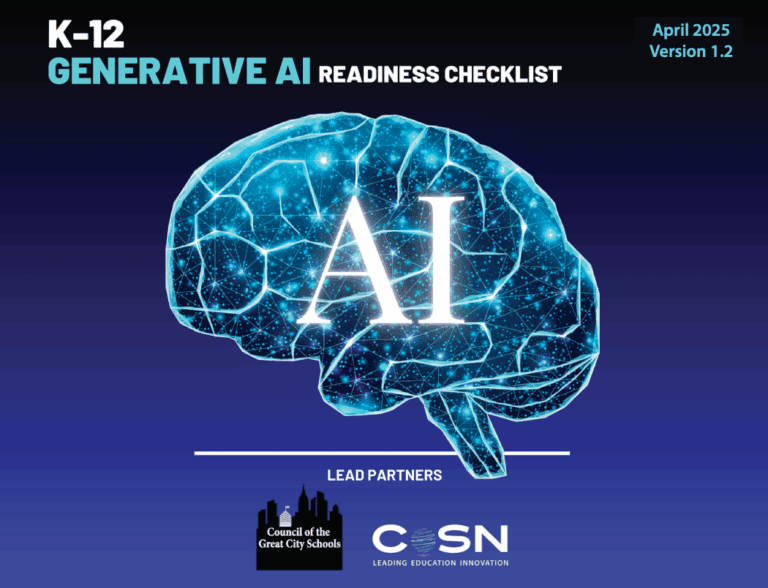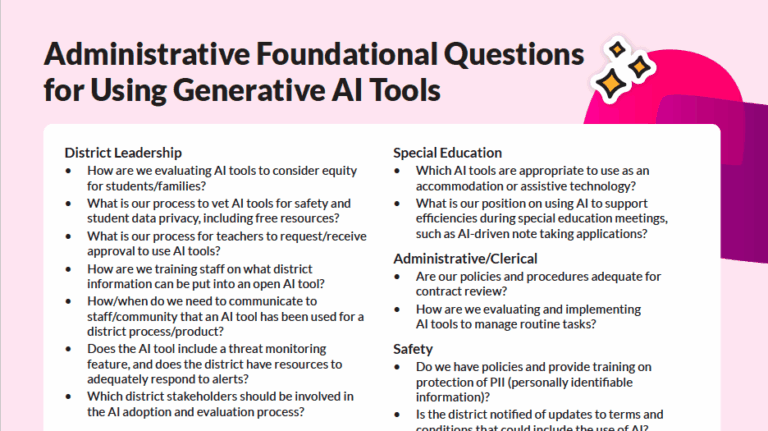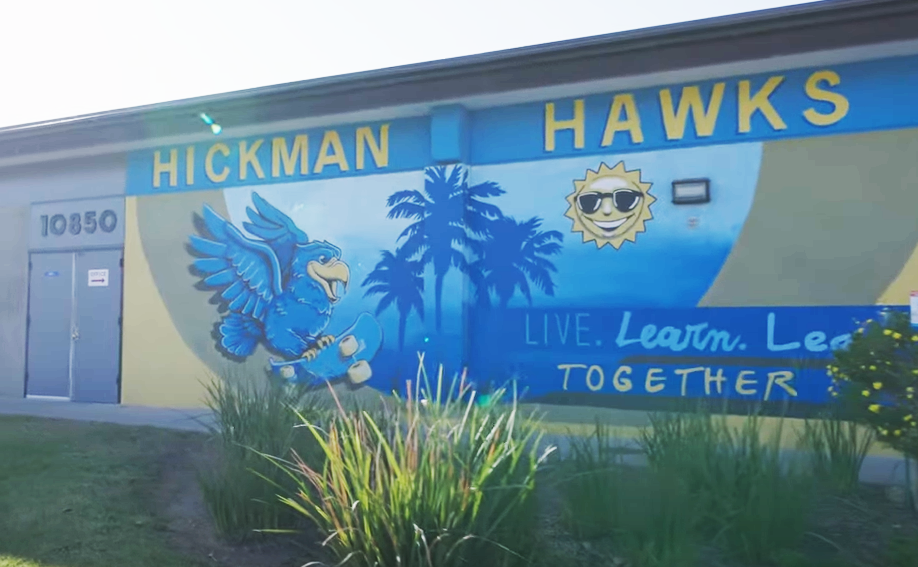
The following article was written by Freddy Castro, Ed.D., assistant principal at Cordova High School in the Folsom-Cordova Unified School District.
In today’s fast-evolving global economy, secondary school leaders face a dual challenge. They must not only ensure students are prepared for college but also help them develop career skills and habits that align with modern workforce demands. The question is, are schools equipped to deliver on both fronts?
For many administrators, the reality is sobering. While some schools excel in building infrastructure to identify, teach and measure these essential skills, others find themselves lacking the tools to bridge the gap (Boettcher, 2017; Flecther et al., 2019; Leu & Arbeit, 2020). This is where Career and Technical Education (CTE) programs come in.
Traditionally, CTE courses in comprehensive high schools have been viewed with skepticism — seen as unaligned with workforce needs or weighed down by outdated stigmas of tracking and gatekeeping (Ferguson, 2018; Ryken, 2006). However, that’s changing. Innovative administrators are rebranding CTE, connecting courses to unified pathways, and aligning them with local workforce demands.
These programs aren’t just about offering technical skills — they represent a powerful blend of academic rigor and practical application. When done right, CTE can serve as a bridge, opening doors to in-demand professions for students who might otherwise face barriers. Research shows that students who complete CTE programs often experience economic and professional advantages compared to their peers (Castellano et al., 2017; Dubeau et al., 2017).
However, the success of CTE programs hinges on more than just federal funding or curriculum updates. Leadership at the local level is the game-changer. High school administrators play a pivotal role in creating environments where these programs can thrive. Successful leaders are actively forming partnerships with local businesses and industry leaders to ensure students gain skills that are in demand (Fletcher et al., 2018). They’re breaking down silos between academic and technical instruction, encouraging collaboration among teachers, and embedding CTE into broader school improvement plans.
These leaders also focus on removing barriers for historically marginalized students, ensuring equitable access to high-quality CTE pathways (Malyn-Smith et al., 2020). Some are reimagining their schools’ schedules to integrate hands-on learning with core academics, while others are investing in staff professional development to help educators better align technical instruction with workforce trends. By fostering a culture that values both academic rigor and career readiness, these administrators are positioning CTE as an essential component of a 21st century education post pandemic.
This article sheds light on the practices of forward-thinking leaders at Cordova High School who are leveraging CTE to meet their college and career readiness goals. By examining these practices, we gain key insights into what makes these programs thrive — and how they can transform educational opportunities for all students. It’s time to recognize CTE for what it truly is: a cornerstone of modern education. With visionary leadership, comprehensive high schools can prepare students not just for college, but for the careers of tomorrow.
In the Folsom-Cordova Unified School District, Cordova High School has been at the forefront of building out its CTE program to implement the “11 Elements of High Quality CTE” for over 10 years, some of which include work-based learning, career technical student organizations, early college credits, industry certificates, and advisory committees. At CHS, academies and career pathways provide students with the opportunity to specialize in various career fields within a supportive, smaller learning environment. For the 2024-25 school year, Cordova High School offers a Culinary, Engineering, Business, and Agricultural Science academy along with Digital Media, Construction, JROTC, and Patient Care pathways.
Each academy is designed with a specific career-field focus and includes both introductory and intermediate CTE courses. The academies offered at CHS are structured to equip students with skills and knowledge that align with industry standards. Each CTE pathway provides a focused approach to career readiness by aligning coursework with students’ specific areas of interest. This approach allows students to explore specialized career fields while maintaining the option to participate in the International Baccalaureate (IB) Programme, ensuring a well-rounded and rigorous educational experience. The intention behind CHS’s design in both its academies and pathways is to ensure that students not only gain theoretical understanding but also hands-on experience, positioning them for success in both post-secondary education and the workforce.
Over the last two years, the administration team at CHS has started diving deeper with the data from the California School Dashboard to analyze how factors such as access, rigor, support, curriculum and program structure have impacted and influenced the “Prepared” level of students in the College/Career Indicator provided on the dashboard. Looking at the programmatic nature of the CTE program here at CHS over the last decade through these data dives has produced generalized themes of the common challenges and successes encountered. The lessons learned give much needed insight to the practices that could potentially help other administrators at comprehensive high schools in maximizing their CTE programs. These themes are summarized below:
Theme 1: Engaging high school students in CTE programs through solutions-focused leadership
Engaging students in CTE programs presents challenges, but forward-thinking leaders are actively implementing solutions to ensure these programs are accessible, equitable and impactful. Scheduling conflicts, a common obstacle, are being mitigated through creative course planning. Administrators and counselors work closely with students and families to balance academic, extracurricular and career interests. Flexible pathways, early exposure to CTE in freshman and sophomore years, and ongoing academic advising ensure students can explore and pursue their interests while still meeting state graduation and college entrance requirements such as the University of California (UC) and California State University (CSU) systems.
Theme 2: Building bridges: Strengthening higher education and industry partnerships for student success
Schools need structured and ongoing dialogue with higher education and industry partners to streamline communication, align goals, and ensure partnerships meet the needs of both students and employers. Administrators must proactively identify and promote work-based learning opportunities as “career readiness currency” for students (NACE, 2024). One example that CHS currently offers its students is a preceptorship to Kaiser Permanente over the summer in the Patient Care Program pathway. In a recent partnership with the Northridge Nursing School, CHS will also offer an immersive “nursing camp” for students interested in the nursing field. These experiences help students build confidence, skills, and connections that open doors to future success.
Theme 3: Empowering CTE programs through central office collaboration: Building a vision for student success
As administrators, we recognize that success often depends on strong, solutions-oriented support from central office leadership. To meet these needs, central office leaders should prioritize developing a unified vision that aligns CTE programs with district goals and workforce demands. Implementing robust evaluation systems can ensure programs are functioning effectively and highlight areas for growth. Moreover, the central office can help schools stay ahead by providing resources for trending innovations that keep CTE pathways engaging and relevant for students. Lastly, central office leadership should act as a bridge, connecting schools with regional assets, industry partnerships and professional development opportunities. By fostering collaboration and offering responsive support, central office leaders can empower school site administrators to create equitable, high-impact CTE programs that prepare students for both college and career success.
Looking toward the future
CTE programs hold the potential to transform the educational landscape by equipping students with the skills, knowledge and opportunities needed to thrive in an ever-evolving economy. However, the success of these programs relies heavily on the leadership of school administrators and the collaborative support of central office leadership. By rebranding CTE, fostering partnerships with industry leaders, and integrating academic rigor with technical skill development, school leaders are breaking down barriers and creating equitable pathways to success.
Ultimately, thriving CTE programs are not just about preparing students for careers — they are about expanding access, equity and opportunity. When schools, districts and communities unite to support these programs, they unlock the potential for students to achieve college and career readiness in meaningful ways, empowering them to succeed in both their professional and personal lives. It’s a vision that demands bold leadership — and one that promises transformative results for generations to come.
References
Boettcher, T. (2017). Cte adapting to meet the demands of today’s economy. Techniques: Connecting Education & Careers, 92(2), 40–43
Castellano, M., Richardson, G. B., Sundell, K., & Stone, I., James R. (2017). Preparing students for college and career in the united states: The effects of career-themed programs of study on high school performance. Vocations and Learning: Studies in Vocational and Professional Education, 10(1), 47.
Dubeau, A., Plante, I., & Frenay, M. (2017). Achievement profiles of students in high school vocational training programs. Vocations and Learning, 10(1), 101–120.
Ferguson, M. (2018). The past, present, and future of cte. Phi Delta Kappan, 2, 64–65.
Fletcher, E. C., Warren, N. Q., & Hernández-Gantes, V. M. (2018). Preparing high school students for a changing world: College, career, and future ready learners. Career and Technical Education Research, 43(1), 77–97. https://doi.org/10.5328/cter43.1.77
Fletcher, E., Tan, T. X., & Hernandez-Gantes, V. M. (2019). A comparative analysis of student engagement in career academies and a comprehensive high school. Career and Technical Education Research, 44(2), 144–176
Leu, K. B., & Arbeit, C. A. (2020). Differences in high school cte coursetaking by gender and race/ethnicity. Career and Technical Education Research, 45(1), 33–62.
Malyn-Smith, J., Juliuson, J., & MacGillivray, S. (2020). CTE and the future of work. Techniques: Connecting Education & Careers, 95(1), 34–39.
National Association of Colleges and Employers. (2024, January 12). What is Career Readiness? https://www.naceweb.org/career-readiness/competencies/career-readiness-defined/
Ryken, A. E. (2006). “Goin’ somewhere”: How career technical education programs support and constrain urban youths’ career decision-making. Career and Technical Education Research, 31(1), 49–71.


































